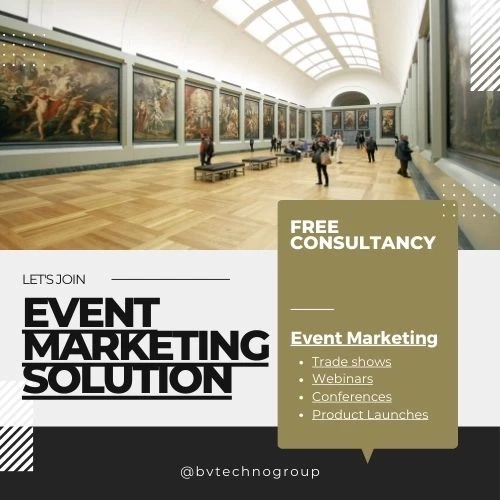BVTECH Event marketing involves organizing and promoting events to connect with potential customers, build brand awareness, and generate leads. This strategy can encompass a variety of event types, both physical and virtual, to engage different audiences.
Key Components of Event Marketing:
- Trade Shows
- Webinars
- Conferences
- Product Launches
Trade Shows
Trade shows are industry-specific events where businesses showcase their products or services to a targeted audience. They provide opportunities for networking, lead generation, and brand exposure.
Key Aspects of Trade Shows:
- Booth Design: Creating an attractive and functional booth that draws visitors and effectively showcases products or services.
- Promotional Materials: Preparing brochures, flyers, business cards, and giveaways to distribute to attendees.
- Staff Training: Ensuring booth staff are well-trained to engage with attendees, answer questions, and capture leads.
- Demonstrations: Offering live demonstrations or presentations to highlight product features and benefits.
- Lead Capture: Using methods such as scanning badges, collecting business cards, or using digital forms to capture contact information for follow-up.
- Networking: Engaging with other exhibitors, industry professionals, and potential partners to build relationships.
- Follow-Up: Promptly following up with leads after the event to nurture relationships and convert prospects into customers.
- Metrics: Measuring success through metrics such as number of leads generated, quality of interactions, and return on investment (ROI).
Webinars
Webinars are online seminars or workshops that allow businesses to present information, conduct training, or discuss industry topics with a remote audience.
Key Aspects of Webinars:
- Topic Selection: Choosing relevant and engaging topics that address the interests and pain points of the target audience.
- Promotion: Using email marketing, social media, and website announcements to promote the webinar and attract registrations.
- Platform Choice: Selecting a reliable webinar platform that supports features like screen sharing, Q&A sessions, and recording.
- Content Preparation: Developing a compelling presentation with clear visuals, engaging content, and a strong narrative.
- Interactive Elements: Incorporating polls, Q&A sessions, and chat features to engage attendees and encourage participation.
- Expert Speakers: Featuring knowledgeable and engaging speakers who can effectively communicate the topic and answer questions.
- Recording and Sharing: Recording the webinar and sharing the replay with registrants and those who missed the live session.
- Follow-Up: Sending follow-up emails with additional resources, thank you notes, and calls to action to continue engagement.
- Analytics: Tracking metrics such as registration numbers, attendance rates, engagement levels, and feedback to evaluate success.
Conferences
Conferences are large events that bring together industry professionals for networking, learning, and sharing ideas. They can be hosted by companies, industry associations, or other organizations.
Key Aspects of Conferences:
- Agenda Planning: Creating a detailed agenda with keynote speeches, breakout sessions, panel discussions, and networking opportunities.
- Speaker Selection: Inviting influential and knowledgeable speakers to attract attendees and provide valuable insights.
- Sponsorship Opportunities: Offering sponsorship packages to other businesses to offset costs and enhance the event experience.
- Attendee Engagement: Providing opportunities for attendees to interact, such as networking sessions, roundtable discussions, and social events.
- Venue Selection: Choosing a suitable venue with appropriate facilities, accessibility, and capacity.
- Marketing: Promoting the conference through various channels, including email marketing, social media, press releases, and partnerships.
- Technology Integration: Utilizing event management software for registration, ticketing, attendee tracking, and feedback collection.
- Post-Event Content: Sharing recorded sessions, presentation slides, and event highlights to extend the reach and impact of the conference.
- Feedback and Evaluation: Collecting feedback from attendees to assess satisfaction and identify areas for improvement.
Product Launches
Product launches are events specifically designed to introduce a new product or service to the market. They aim to generate buzz, attract media attention, and drive initial sales.
Key Aspects of Product Launches:
- Launch Plan: Developing a detailed plan that includes timelines, goals, and promotional strategies.
- Target Audience: Identifying and inviting key stakeholders, potential customers, media representatives, and influencers.
- Event Format: Deciding on the format, whether it’s a live event, virtual launch, or a hybrid model.
- Teasers and Announcements: Creating pre-launch buzz through teasers, social media posts, email campaigns, and press releases.
- Presentation: Preparing a compelling presentation or demonstration that highlights the product’s features, benefits, and unique selling points.
- Media Coverage: Engaging with media and influencers to secure coverage and amplify the reach of the launch.
- Interactive Elements: Including interactive elements such as Q&A sessions, live demos, and hands-on experiences to engage attendees.
- Promotional Materials: Providing attendees with brochures, fact sheets, and samples to take away.
- Follow-Up Campaigns: Implementing follow-up marketing campaigns to sustain interest and drive post-launch sales.
- Metrics: Measuring the success of the launch through metrics such as media coverage, social media engagement, attendee feedback, and initial sales figures.
Conclusion
BVTECH Event marketing through trade shows, webinars, conferences, and product launches offers diverse and effective ways to engage with audiences, build brand awareness, and generate leads. Trade shows provide direct interaction with potential customers, webinars offer valuable content and remote engagement, conferences facilitate networking and knowledge sharing, and product launches create excitement and drive initial sales. By strategically planning and executing these events, businesses can achieve their marketing objectives and strengthen their market presence.
- New



